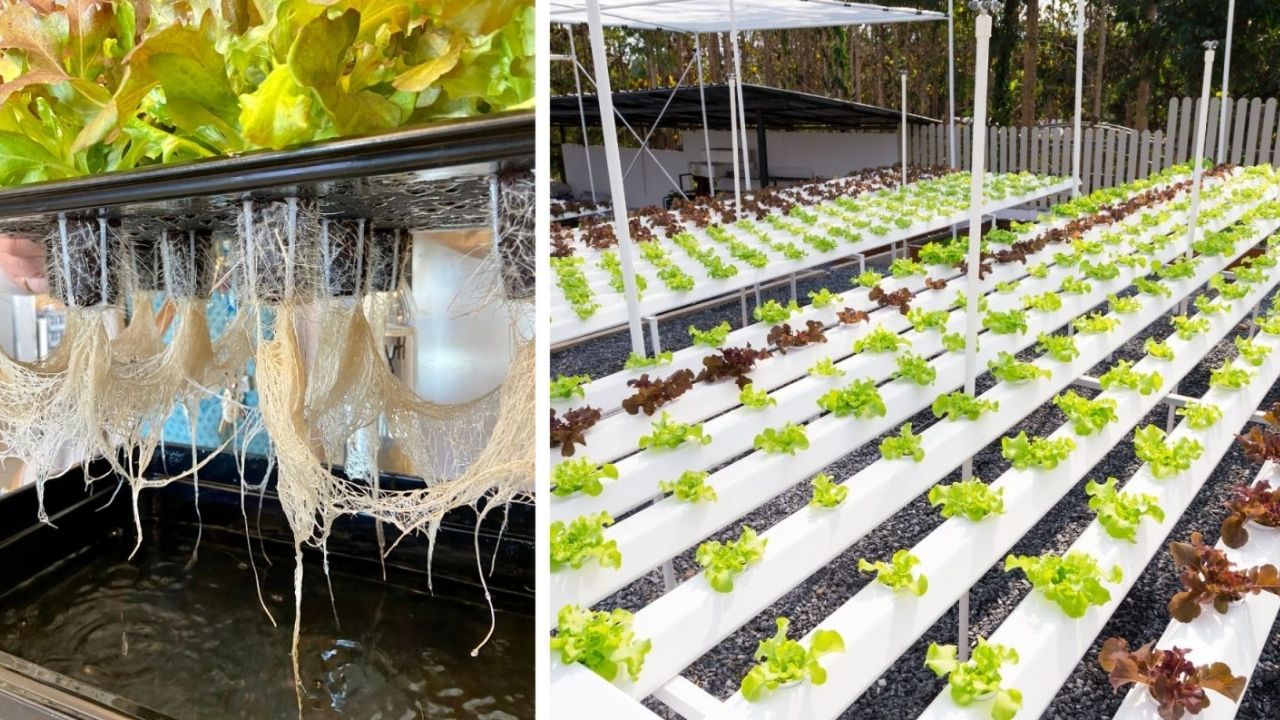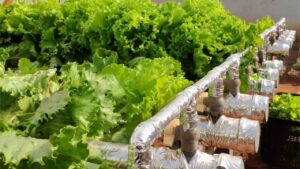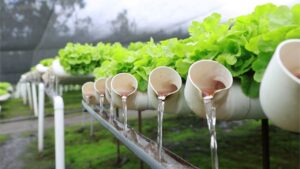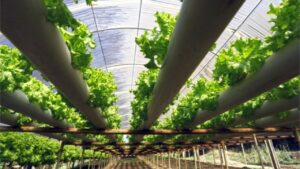Hydroponic farming is an innovative technique for growing plants without soil, replacing it with nutrient-rich water solutions. This method allows for the efficient and sustainable growth of vegetables and greens through a closed system that optimizes available resources and space. It has gained increasing popularity, especially in urban environments where access to fertile land is limited.
In recent years, the search for alternative agricultural methods, which are more sustainable and can meet the growing demand for food, has intensified. Hydroponic farming emerges as a promising solution, enabling the production of fresh, high-quality food without the limitations of traditional farming. With increasing urbanization and climate change, adopting techniques like hydroponics is essential to ensure food security, reduce resource waste, and boost urban agriculture.
This topic becomes even more relevant in today’s context, where sustainability and food production efficiency are urgent concerns. By opting for hydroponic farming, it is possible to cultivate more intelligently, without compromising the environment and with a lower impact on the planet.
What is Hydroponic Farming?
Hydroponic farming is a method of growing plants that does not rely on soil. Instead, the plants’ roots grow immersed in a nutrient solution composed of water and the necessary nutrients for their development. This system allows plants to absorb nutrients efficiently and directly, without the limitations of soil, such as quality or nutrient availability.
What sets hydroponics apart from traditional farming is the absence of soil. In conventional agriculture, soil serves as both the support medium and the source of nutrients for plants. In hydroponics, nutrition is provided directly through water, allowing for more precise control over what the plants are consuming. Additionally, hydroponic farming can be done in enclosed environments, such as greenhouses or urban spaces, making it an ideal solution for areas with limited arable land.
The main components of a hydroponic system include:
- Nutrient Reservoir: Where the nutrient solution is stored. It provides the necessary substances for plant growth.
- Irrigation System: Responsible for distributing the nutrient solution to the plant roots, ensuring they receive the right amount of water and nutrients.
- Support Medium: Instead of soil, plants are supported by materials like perlite, coconut fiber, or expanded clay, which help anchor the roots in place and allow water circulation.
- Lighting (when necessary): In enclosed spaces, artificial lighting may be needed to ensure plants receive the appropriate amount of light for photosynthesis.
- Monitoring: Sensors and control systems help monitor and adjust factors such as pH, temperature, and nutrient levels, providing an ideal environment for plant growth.
The simplicity and efficiency of these components make hydroponic farming an increasingly popular option, especially in places with limited space and natural resources.2. Environmental Benefits of Hydroponic Farming
Hydroponic farming offers a range of environmental benefits, making it a more sustainable alternative compared to traditional agricultural methods. Below, we highlight some of the key positive impacts of hydroponics on the environment:
Efficient water use (reducing waste)
One of the biggest challenges of conventional farming is excessive water use. In hydroponic farming, water is used more efficiently, as it circulates in a closed system. The nutrient solution can be reused multiple times, significantly reducing water waste. It is estimated that hydroponics consumes up to 90% less water than traditional farming methods, which is especially important in regions with water scarcity.
Reduced use of pesticides and herbicides
In conventional agriculture, the use of pesticides and herbicides is common to combat pests and weeds. However, in hydroponic farming, pest control is more efficient and often unnecessary, as plants grow in a controlled and isolated environment. This results in a significant reduction in the application of chemicals, minimizing the negative impacts on local ecosystems and human health.
Reduction of carbon footprint
The carbon footprint associated with traditional agriculture includes, among other factors, the use of fossil fuels for transportation and the large-scale use of land. In hydroponic farming, especially in urban systems, this carbon footprint can be reduced. Cultivation can be done locally, near urban centers, reducing the need for long-distance food transportation and, as a result, decreasing greenhouse gas emissions.
How hydroponics contributes to urban farming and sustainability
Hydroponic farming is one of the key practices for promoting sustainability in cities. It allows fresh food to be grown in urban areas, using small or underutilized spaces, such as rooftops, walls, and abandoned lots. This not only improves access to fresh food but also reduces the environmental impact of large monocultures, promoting diversity and more intelligent use of urban space. Furthermore, hydroponic systems are flexible and can be scaled up according to demand, making them an effective solution for sustainable urban agriculture.
In summary, hydroponic farming not only optimizes the use of natural resources like water and soil but also offers a more ecological and responsible approach to food production. This makes it an increasingly attractive option for addressing the environmental challenges of today and the future.
- See Also: Hydroponic Garden as a Sustainable Solution for Small Spaces
- Follow Us: https://www.facebook.com/profile.php?id=61565885846819
Economic and Practical Benefits
In addition to environmental benefits, hydroponic farming also offers significant economic and practical advantages for both producers and consumers. Below, we explore the key economic and practical benefits of this technique:
Lower costs for natural resources (such as soil)
One of the biggest advantages of hydroponics is the elimination of the need for soil. In conventional farming, soil must be prepared, fertilized, and maintained, which involves maintenance costs and constant care. In hydroponics, the system uses alternative substrates like perlite or coconut fiber and a nutrient solution, significantly reducing the costs of natural resources. Additionally, the practice is more efficient because large areas of land are not required, making production more accessible in areas with poor-quality soil or in urban spaces.
Higher productivity per square meter
Hydroponic farming allows for much higher productivity per square meter compared to traditional methods. Since plants are grown in a more controlled environment, within compact and organized systems, it is possible to achieve more harvests in less space. This translates into more efficient use of available area, which is especially advantageous in urban environments or places with limited space. In many cases, it is possible to grow 3 to 4 times more in the same area compared to traditional soil-based farming.
Cultivation in smaller areas and urban spaces
The ability to cultivate in smaller and urban spaces is one of the key attractions of hydroponic farming. It can be practiced in areas where soil is scarce or unavailable, such as apartments, rooftops, balconies, or even inside warehouses. This makes food production more accessible not only in rural areas but also for people in urban environments. Furthermore, cultivation in smaller spaces allows for the creation of urban gardens, improving access to fresh, local food in large cities.
Accessibility for beginners and entrepreneurs
Hydroponics is a technique that offers great accessibility for both beginners and entrepreneurs. Hydroponic systems vary in complexity, from simple and low-cost models ideal for beginners to more advanced solutions that can be implemented on a large scale by those looking to start an agricultural business. With the advancement of technology and the growing availability of hydroponic kits, it is becoming increasingly easier for anyone to start growing their own plants, whether as a hobby or as a source of income. Additionally, for entrepreneurs, hydroponic farming offers a sustainable business opportunity with the potential for quicker financial returns due to higher productivity and fewer resource needs.
In summary, hydroponic farming not only helps improve resource efficiency but also provides an excellent opportunity for those looking to start growing food in a practical and economical way, whether on a small or large scale.
Quality and Taste of Hydroponic Food
The quality and taste of hydroponically grown food has been a topic of discussion, but many studies and experiences show that this technique can indeed produce food that is as flavorful and nutritious as soil-grown produce, and in some cases, even surpass it. Below, we discuss how hydroponics impacts the nutritional quality and taste of vegetables, as well as highlight some foods that adapt well to this practice.
Comparison with soil-grown food
Compared to soil-grown food, hydroponic plants often benefit from more precise and controlled nutrition. In traditional farming, soil quality can vary significantly, which directly affects the growth and health of plants. In hydroponics, the nutrient solution provides exactly what the plant needs, at the right time, without the variations that soil may present. This results in vegetables with greater consistency in terms of taste and appearance.
The impact of the technique on nutritional quality and taste
The nutritional quality of hydroponic food can be superior in some aspects, as plants receive a balanced and controlled dose of nutrients, which can increase the concentration of vitamins and minerals. Additionally, the fact that the crops are grown in controlled environments, free from environmental contaminants, can also contribute to better nutritional quality. As for taste, hydroponic vegetables are often fresher and more intense, as they are grown under ideal conditions of light, temperature, and humidity, which enhances their natural flavor. Some growers report that hydroponic vegetables taste sweeter and crisper, especially leafy greens like lettuce and arugula.
Examples of foods that adapt well to hydroponics
Hydroponic farming is particularly suitable for growing leafy greens and herbs, which can grow quickly in hydroponic systems. Examples include:
- Lettuce: One of the most popular crops in hydroponics, lettuce grows quickly and benefits from the controlled conditions offered by hydroponic systems.
- Spinach: Another plant that adapts well to hydroponic cultivation, spinach grows rapidly and offers excellent flavor.
- Basil and other aromatic herbs: Herbs like basil, cilantro, mint, and parsley thrive in hydroponic systems, offering intense and fresh flavors.
- Tomatoes and cucumbers: Although growing fruit can be more challenging in hydroponic systems, tomatoes and cucumbers can be successfully grown in more advanced systems, providing flavorful and high-quality produce.
In summary, hydroponic food can have excellent nutritional quality and delicious taste, often surpassing that of soil-grown produce, especially when grown in optimized systems. The hydroponic technique offers the opportunity to produce fresh and flavorful food in a sustainable and efficient way.
How to Start a Hydroponic Garden at Home
Starting a hydroponic garden at home can be a fun and rewarding experience. While the process requires some planning and initial investment, it offers great benefits such as fresh food and the ability to grow in small spaces. Below, we outline the basic steps to set up a simple hydroponic system, as well as tips and essential equipment to ensure your garden’s success.
Basic Steps to Set Up a Simple Hydroponic System
- Choose the type of hydroponic systemThere are several types of hydroponic systems, such as the Ebb and Flow system, Nutrient Film Technique (NFT), and Deep Water Culture (DWC) system. For beginners, the Deep Water Culture (DWC) system is one of the simplest options, as plants are suspended in a nutrient solution with their roots submerged in a container. It’s a great option to start without much complexity.
- Select the container and substrateChoose a container or box that can hold the nutrient solution and support the plants. The substrate, such as perlite, expanded clay, or coconut coir, will serve as support for the plant roots. These materials are lightweight and allow for good water circulation.
- Prepare the nutrient solutionThe nutrient solution is made up of water and specific fertilizers that provide essential nutrients for plant growth. You can buy a ready-made solution or prepare your own, depending on the needs of the plants you choose.
- Install lighting (if necessary)If you don’t have enough natural light, it’s important to install grow lights, such as LED or fluorescent lamps. These will help promote photosynthesis and ensure healthy plant growth.
- Monitoring and controlOne of the keys to success in hydroponic gardening is constant monitoring. Be sure to check the pH and nutrient levels of the solution regularly, and ensure the plants receive proper light and temperature.
Tips for Beginners: Choosing Plants, Maintenance, and Essential Care
- Choosing plants: For beginners, it’s recommended to start with fast-growing and low-maintenance plants, such as lettuce, spinach, basil, and arugula. These plants adapt well to the hydroponic environment and don’t require excessive care.
- Maintenance and care: Hydroponic plants require regular attention, especially regarding the nutrient solution. Keep the water clean, change the nutrient solution as needed, and check the health of the plants. It’s also important to monitor the pH of the water, which should be between 5.5 and 6.5 to ensure that the plants absorb nutrients properly.
- Temperature and humidity: Most hydroponic plants prefer temperatures between 18ºC and 24ºC (64ºF to 75ºF). Additionally, maintain humidity levels between 50% and 70% to promote healthy plant growth.
Tools and Equipment Needed
- Reservoir for the nutrient solution: A simple container, such as a plastic box, as long as it has enough capacity to store water and nutrients.
- Irrigation system or water pump: Depending on the type of hydroponic system you choose, you’ll need a pump to circulate the nutrient solution.
- Artificial lighting (if needed): LED or fluorescent grow lights.
- Thermometer and pH meter: To monitor water temperature and pH levels.
- Substrates like perlite, coconut coir, or expanded clay: To support the plant roots.
- Nutrient solution: Liquid fertilizers to provide the necessary nutrients.
With these steps and tips, you will be ready to start your hydroponic garden at home. In addition to being a rewarding experience, it provides fresh and healthy food, with the benefit of being practical and accessible even for beginners.
Challenges and Limitations of Hydroponic Farming
While hydroponic farming offers various benefits, such as efficient resource use and the ability to grow in urban environments, it also presents challenges and limitations that should be considered. In this section, we discuss the main obstacles to growing hydroponic plants and the difficulties that may arise when implementing this method.
Initial Costs and System Maintenance
One of the biggest challenges of hydroponic farming is the initial cost of setting up the system. Purchasing equipment such as reservoirs, irrigation systems, pumps, artificial lighting (if necessary), and substrates can represent a significant investment. Additionally, the ongoing maintenance of the systems, such as replacing nutrient solutions, monitoring pH levels, and controlling temperature and humidity, can also incur costs. These expenses can be a barrier for those looking to start a hydroponic garden at home or on a small scale. However, it is important to note that, in the long run, these costs can be offset by the reduction in the use of inputs like fertilizers and pesticides.
Constant Monitoring Requirement
Hydroponics requires constant monitoring to ensure that growing conditions are optimal for plant development. This involves frequent checking of water pH, nutrient levels, temperature, and humidity, among other factors. Since plants rely on an artificial system for their nutrition and growth, even the smallest failure in the system can negatively impact the plants. This means that to be successful in hydroponic farming, it is necessary to dedicate time and attention regularly to the system, which can be a challenge for those with busy schedules.
Types of Plants That Don’t Adapt Well to Hydroponics
While many types of plants adapt well to hydroponic farming, there are some that are less suited to this system. Plants that require large amounts of soil or have deep roots, such as potatoes, carrots, and beets, may not thrive well in hydroponic systems. This is because they need more space and denser substrates, characteristics that hydroponics does not provide. Additionally, plants that require more specific growing conditions, such as large fruits or perennial plants, may be challenging to grow hydroponically, as they require more advanced systems and special care regarding their feeding and growth.
In summary, while hydroponic farming is advantageous in many ways, it does come with challenges in terms of costs, the need for continuous maintenance, and choosing the right plants. For those willing to invest time, effort, and resources, these obstacles can be overcome, making the practice an excellent option for sustainable and efficient food production.
Success Stories of Hydroponic Farming
Hydroponic farming has emerged as an innovative and sustainable alternative for food production, with success stories around the world, including Brazil. These examples demonstrate how the technique can be applied under various conditions and on different scales, from small home gardens to large commercial projects. Below are some success stories and innovative projects that contribute to more efficient and sustainable food production.
Success stories in Brazil and worldwide
In Brazil, hydroponic farming has gained prominence, especially in urban areas where space for cultivation is limited. A notable example is the project “Horta Hidropônica Urbana”, which aims to transform underutilized urban areas into productive spaces using hydroponic systems to grow vegetables and herbs. This project not only contributes to local food security but also promotes awareness of more sustainable agricultural practices.
Another successful example in Brazil is Sítio Hidropônico, located in the interior of São Paulo. This project, focused on the commercial production of lettuce and other vegetables, uses hydroponic systems to cultivate in a small space, with high productivity and without the use of pesticides. The success of this farm demonstrates how hydroponics can be a solution for small farmers looking to increase their production without relying on large plots of land.
Globally, The Vertical Farm Project in Singapore is an impressive example of how hydroponics can be applied on a large scale to meet the food needs of a population in a densely urbanized area. The project uses vertical hydroponic farming techniques, where plants grow in stacked layers, maximizing space usage. This project not only aims to provide fresh food to the city but also minimize the carbon footprint associated with transporting food from other regions.
Another successful global example is AeroFarms, a U.S.-based company that uses vertical aeroponic hydroponics to grow vegetables in controlled indoor environments. They produce leafy greens on a large scale with 95% less water usage than conventional farming, without the need for pesticides, making them a global leader in sustainable agriculture.
Innovative projects and their contribution to sustainable food production
These projects not only demonstrate the viability and success of hydroponics but also highlight the importance of the technique in promoting food sustainability. By reducing the use of soil, conserving water, and minimizing the need for pesticides and herbicides, hydroponic farming contributes to more efficient and environmentally friendly food production.
Moreover, many of these projects aim to integrate agriculture into urban environments, making fresh and high-quality food more accessible even in densely populated areas. This is especially important in times of increasing urbanization and scarce natural resources.
In summary, the success stories of hydroponic farming, both in Brazil and worldwide, show how this technique can be an innovative solution for sustainable and efficient food production. These projects not only demonstrate the feasibility of hydroponics but also highlight its potential to contribute to global food security and environmental preservation.
Conclusion
By using less water, reducing the need for soil, and eliminating pesticide use, it directly contributes to environmental sustainability. Additionally, hydroponics allows for more efficient production in reduced urban spaces, with higher productivity per square meter, making it ideal for cultivation in areas with limited space.
The economic and practical benefits are also clear, as the technique can reduce costs associated with natural inputs and allow for the cultivation of fresh, nutritious food year-round. Moreover, with the advancement of simple and accessible systems, even beginners and small entrepreneurs can benefit from hydroponic farming.
Adopting innovative agricultural techniques like hydroponics is crucial to ensuring food production is more efficient without harming the environment. By investing in more sustainable practices, we are not only improving the quality of our food but also helping to create a more balanced future for the planet.
If you’re ready to start your journey toward healthier and more sustainable eating, start your hydroponic garden today! No matter the size of your space, you can grow your own fresh, delicious plants, contributing to a greener and more responsible future.




